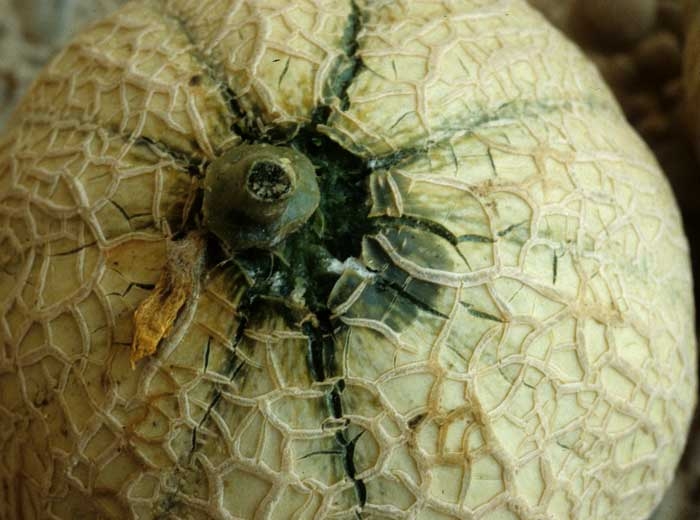
Trichothecium roseum (Pers.) Link 1809
Pink rot
- téléomorphe : Hypocreales
- English names: pink rot, pink mold rot
T. roseum is a fungus widely distributed in the world, frequently observed on the most diverse plant debris, on the carpophores of fungi, sometimes showing myco-parasitism. Often saprophytic, sometimes a weakness or opportunistic parasite, it is particularly responsible for rots on several fruits, on roses, under the name of pink rot (pink rot) or pink mold rot. Note that on vines, this fungus is mainly observed on the clusters, developing secondarily to gray rot caused by Botrytis cinerea .
It is reported on melon fruits from several countries in North and South America, in Spain, Israel, China, and even in France where it is sporadically observed on melon fruits. Its symptoms are observed in the open field, but especially on fruits harvested during storage.
As we suggested previously, it is able to attack other pathogenic fungi of plants such as Sclerotinia sclerotiorum , Apiosporina morbosa , Botrytis allii ...
Let us add that it is likely to produce in particular a mycotoxin in the altered tissues: trichothecene .
Symptoms
The affected fruits present a large lesion starting at the level of the peduncle (figures 1 and 2) or stylar (figure 3) scars, on the side of the fruits or from a wound such as a burst for example. Affected tissues initially take on a dark green tint (Figure 1), turn slightly brown, while a sour rot gradually sets in.
If the climatic conditions are humid, these lesions become covered with a rather characteristic pink mold (figure 2), not to be confused with those of Fusarium .
Elements of biology
T. roseum has biological characteristics quite comparable to those of several other fungi found on the fruits of Cucurbitaceae. It probably lives as a saprophyte on these plants and in their environment.
- Storage and sources of inoculum
This fungus is probably present in many production areas of Cucurbitaceae in the world: in the soil, on various plants and on plant debris .... It is known to affect various fruits (apple, pear, plum, cherry, grape ... ) and some vegetables (melon, cucumber, watermelon, tomato ) ... These "alternative" hosts thus help to multiply and preserve them.
- Plant penetration and host invasion
It is observed on fruits often when ripe. It settles there through the stilar scar, various injuries (peduncular wound, bursting ...). Subsequently, its mycelium develops extensively, invades the tissues which are gradually degraded.
Note that T. roseum is likely to produce a mycotoxin, a trichothecene.
- Sporulation and dissemination of fungi
This fungus sporulates abundantly on the surface of rotten fruits and covers them more or less with its pink mold. Its conidia are dispersed by air currents and / or splashing water following rains.
- Factors influencing the development of fungi
It grows rapidly and sporulates abundantly in the presence of humidity and when temperatures are mild. Its thermal optimum is between 20 and 25 ° C, it continues to develop up to 10 ° C and even below.
Protection methods
In France, the damage caused by T. roseum on Cucurbitaceae is not serious enough to require the implementation of special protection methods.
However, it is worth emphasizing the value of the following measures:
- ensure optimum comfort for the plants and avoid injuring the fruit at all costs (insect damage, mechanical injuries, etc.);
- improve the ventilation of vegetation as much as possible in order to reduce humidity
- avoid conditions of persistent humidity on the vegetation cover and fruits;
- carefully harvest the fruits and avoid injuring them.
Note that in some countries the fruits undergo the action of various treatments to reduce as much as possible the pathogenic fungi in post-harvest, and therefore to preserve them better.
* Chemical control : As the number of pesticides available for a given use is constantly changing, we advise you to always confirm your choice by consulting the e-phy site of the Ministry of Agriculture and Fisheries which is an online catalog of plant protection products and their uses, fertilizers and growing media approved in France. This also applies to all biological products based on microorganisms or natural substances.





